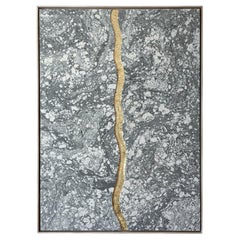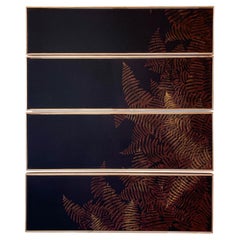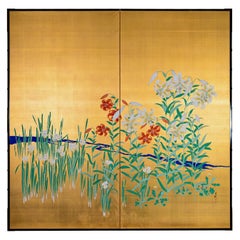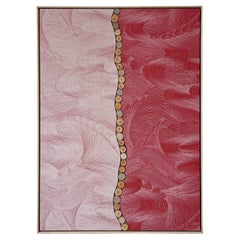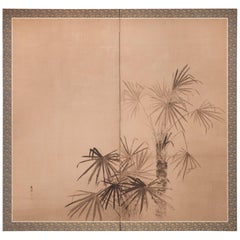Silk Paintings and Screens
to
94
310
106
504
34
1
8
4
2
1
45
213
246
35
115
46
16
11
3
18
7
3
10
8
3
773
759
722
539
492
519
504
425
53
16
539
521
526
30
2
1
1
1
Material: Silk
17th Century Japanese Two-Panel Screen, Gibbons of Folklore
Located in Hudson, NY
Japanese two-panel screen: Gibbons of Folklore, Edo period (17th century) Kano School painting of gibbons in Japanese fables. The left panel represents a Japanese fable of a monkey a...
Category
Late 17th Century Japanese Edo Antique Silk Paintings and Screens
Materials
Silk, Wood, Paper
Vintage kimono textile art "Marble Story ~ Healing ~" by ikasu Grey, Japan
By Kimono ikasu
Located in Setagaya City, JP
This work uses a vintage kimono fabric with marble pattern, that makes it look like a real piece of marble.
The line in the middle symbolizes “kintsugi” - concept of wabi-sabi, which values imperfection, impermanence, and the beauty of aging.
It is elegantly framed with paulownia wood originally used for kimono chest-of-drawers, and is filled with storytelling and sense of luxury.
I used pieces of kimono that could no longer be used as clothing and kiritansu chest-of-drawers that would normally be discarded to create the ultimate upcycled piece.
<< Explanation and meaning of pattern and colors >>
Kintsugi (金継ぎ), which translates to "golden joinery" or "golden repair," is a traditional Japanese art form of repairing broken pottery with lacquer mixed with powdered gold, silver, or platinum. I used this tecnique here to "repair" antique kimono by transforming it into art work. Beyond its literal meaning of mending broken ceramics, kintsugi carries profound philosophical and cultural significance in Japanese tradition:
・Embracing Imperfection: Kintsugi celebrates imperfection and impermanence. Rather than disguising or concealing flaws, it highlights them, treating the breakage as part of the object's history. This philosophy encourages acceptance of imperfection as an essential aspect of life, beauty, and human experience.
・Wabi-Sabi Aesthetic: Kintsugi embodies the principles of wabi-sabi, an aesthetic worldview centered on the acceptance of transience and imperfection. Wabi-sabi values simplicity, authenticity, and the beauty of things that are imperfect, impermanent, and incomplete. Kintsugi exemplifies these principles by turning what might be considered flaws into features that enhance the object's beauty and character.
・Resilience and Transformation: The act of repairing broken things with precious metals symbolizes resilience and transformation. Instead of discarding or replacing the broken object, kintsugi honors its history and transforms it into something new and valuable. This reflects broader philosophical themes of overcoming adversity, finding beauty in imperfection, and embracing change.
・Honoring the Past: Kintsugi preserves and honors the history of the object. Rather than erasing or ignoring its past, it acknowledges and celebrates it. This aspect of kintsugi can be seen as a metaphor for honoring our own personal histories, including the challenges and setbacks we have faced, and recognizing how they have shaped us into who we are today.
・Spiritual and Philosophical Symbolism: Kintsugi has spiritual and philosophical implications, reflecting concepts such as the interconnectedness of all things, the cycle of life and death, and the pursuit of harmony and balance. The process of repairing broken objects with precious metals is seen as a metaphor for spiritual growth, enlightenment, and the journey towards wholeness.
Overall, kintsugi represents not only a practical technique for repairing ceramics but also a profound philosophical and cultural perspective on life, beauty, and the human experience. It embodies values such as resilience, acceptance, and the transformative power of embracing imperfection.
<< Characteristics of the fabric >>
This vintage textile is hand-painted with a traditional painting technique where the colors are added on wet surface, which creates an effect of marble.
<< About the frame >>
Kiritansu - chest-of-drawers for kimono, is traditionally made from paulownia wood, a uniquely Japanese material closely tied to the world of kimonos.
Paulownia wood is known as the lightest wood in Japan, prased for its natural luster, resistance to moisture, and resilience against cracking. Since ancient times, it has been used in crafting furniture, chests, and musical instruments.
During the Edo period, it became customary to store cherished kimonos in paulownia chests...
Category
1960s Japanese Japonisme Vintage Silk Paintings and Screens
Materials
Gold Leaf
Vintage kimono textile art "Fern ~Connection to Nature~" by ikasu Black , Japan
By Kimono ikasu
Located in Setagaya City, JP
This work uses an antique tomesode (festive kind of kimono) with fern design to evoke feelings of tranquility, harmony, and appreciation for the beauty of the environment. Can be used both vertically and horizontally.
It is elegantly framed with paulownia wood originally used for kimono chest-of-drawers, and is filled with storytelling and sense of luxury.
I used pieces of kimono that could no longer be used as clothing and kiritansu chest-of-drawers that would normally be discarded to create the ultimate upcycled piece.
<< Explanation of colors and patterns >>
In Japanese traditional culture, ferns, particularly the Japanese painted fern (Athyrium niponicum), hold several meanings and symbolisms:
・Elegance and Beauty: Ferns are admired for their graceful, delicate appearance and intricate leaf patterns. In Japanese aesthetics, they are appreciated for their natural beauty and are often used in gardens, landscapes, and floral arrangements to add a sense of refinement and elegance.
・Resilience and Perseverance: Ferns are known for their ability to thrive in diverse environments, including shady forests, rocky cliffs, and damp soil. Their resilience in the face of challenging conditions is seen as a symbol of endurance and perseverance. In Japanese culture, ferns may represent the ability to overcome adversity and flourish despite obstacles.
・Connection to Nature and Tranquility: Ferns are native to forested areas and are often associated with the natural world. In Japanese traditional culture, they symbolize a deep connection to nature and the importance of maintaining harmony with the environment. The lush green foliage of ferns evokes feelings of tranquility and peacefulness, making them popular motifs in Zen gardens and traditional landscape paintings.
・Purity and Simplicity: Ferns are emblematic of simplicity and purity in Japanese aesthetics. Their unassuming beauty and understated elegance reflect the principles of wabi-sabi, an aesthetic worldview that values imperfection, impermanence, and simplicity. Ferns may be used in tea ceremonies, Ikebana (flower arranging), and other traditional arts to evoke a sense of tranquility and appreciation for life's fleeting moments.
Overall, ferns in Japanese traditional culture symbolize elegance, resilience, connection to nature, purity, and simplicity. Their presence in art, literature, and landscape design underscores their enduring significance as symbols of natural beauty and spiritual resonance.
<< Characteristics of the fabric >>
This vintage textile is hand-painted with a traditional Japanese technique called "yuzen".
<< About the frame >>
Kiritansu - chest-of-drawers for kimono, is traditionally made from paulownia wood, a uniquely Japanese material closely tied to the world of kimonos.
Paulownia wood is known as the lightest wood in Japan, prased for its natural luster, resistance to moisture, and resilience against cracking. Since ancient times, it has been used in crafting furniture, chests, and musical instruments.
During the Edo period, it became customary to store cherished kimonos in paulownia chests...
Category
1960s Japanese Japonisme Vintage Silk Paintings and Screens
Materials
Silk, Wood
Japanese Two Panel Screen: Flowers by River's Edge
Located in Hudson, NY
Mineral pigments on gilded silk with gilded bronze hardware. Signature reads: Shunkan.
Category
1930s Japanese Vintage Silk Paintings and Screens
Materials
Bronze
Vintage kimono textile art "Sunset Timelapse ~Ephemerality~" by ikasu Red, Japan
By Kimono ikasu
Located in Setagaya City, JP
The art piece uses two sides - front and reverse - of the same kimono, to show beautiful sea surrounding Japan, in hues and in late sunset, as a timelapse.
The frame for this work is made of paulownia wood taken from antique Kiritansu - chest-of-drawers for kimono.
I use antique kiritansu that can’t be used as furniture anymore to create basis and frames for my works. It adds them even more authentic atmosphere of traditional wabisabi spirit. Can you feel it?
<< Period / Story >>
The kimono used in this piece was originally crafted during Showa period (around 1960ies).
<< Explanation and meaning of pattern and colors >>
Sea waves, depicted in two color variations here, are a symbol of transience and Impermanence in Japanese culture. The ebb and flow of the tides, the ever-changing currents, and the relentless motion of the waves serve as reminders of the fleeting nature of life. This artwork featuring the sea convey themes of impermanence, reminding viewers to cherish the present moment and appreciate the beauty of life's fleeting moments.
The theme of impermanence is strengthen by two colors of the sea - the lighter in early hues and the darker when the sun is just about to set in the sea.
<< About the frame >>
This artwork frame is crafted from paulownia wood, a uniquely Japanese material closely tied to the world of kimonos, and it serves to convey the refined beauty of Japanese nature.
Paulownia wood is known as the lightest wood in Japan, prased for its natural luster, resistance to moisture, and resilience against cracking. Since ancient times, it has been used in crafting furniture, chests, and musical instruments.
Paulownia wood is closely linked to kimono culture. During the Edo period (17th cent.~), it became customary to store cherished kimonos in paulownia chests...
Category
1960s Japanese Japonisme Vintage Silk Paintings and Screens
Materials
Silk, Wood
Japanese Two-Panel Screen Ink Painting of Palm Trees on Paper
Located in Hudson, NY
Japanese two-panel screen: ink painting of Palm Trees on paper, Edo period (1787) beautiful painting of Japanese windmill palm trees. Ink paint...
Category
18th Century Japanese Edo Antique Silk Paintings and Screens
Materials
Silk, Wood, Paper
18th Century Japanese Two-Panel Screen Collection of Fans on Gold
Located in Hudson, NY
18th century Japanese Screen of a Collection of Fans. Paintings on fans depict famous Japanese painting subjects, this screen was most li...
Category
18th Century Japanese Edo Antique Silk Paintings and Screens
Materials
Gold Leaf
Japanese Two Panel Screen Moon Rising Through Bamboo on Silver Leaf
Located in Hudson, NY
Japanese two panel screen: Moon rising through bamboo on silver leaf, Meiji period painting (1868 - 1912) of the moon rising on the horizon with a garden stone in the foreground. Lic...
Category
Early 20th Century Japanese Meiji Silk Paintings and Screens
Materials
Silver Leaf
VIntage kimono textile art " Monochrome Geometry " by ikasu Gold, Grey, Japan
By Kimono ikasu
Located in Setagaya City, JP
This work is inspired by traditional Japanese nature colors symbolism, and is framed in paulownia wood originally used for a kimono chest-of-drawers.
It is filled with storytelling ...
Category
1960s Japanese Japonisme Vintage Silk Paintings and Screens
Materials
Silk, Wood
Late 17th-Early 18th Century Japanese Six-Panel Screen, Battle at Uji Bridge
Located in Hudson, NY
Japanese six-panel screen: Battle at Uji Bridge, the first battle at Uji was in 1180 and it marked the start of the Heike Wars. The Genji troops crossed the...
Category
Late 17th Century Japanese Edo Antique Silk Paintings and Screens
Materials
Gold Leaf
Japanese Two-Panel Screen, Azalea Tree with Birds
Located in Hudson, NY
Beautifully painted Japanese two-panel screen with vibrant azalea tree with finches, camellia tree, and yellow azaleas. Mineral pigments and gold dust on gold silk background. Signat...
Category
Early 20th Century Japanese Silk Paintings and Screens
Materials
Silk
Japanese Two-Panel Screen, Young Pine in Snow
Located in Hudson, NY
Beautifully painted by Kido So (1899 - 1984). Born in Kyoto So studied painting at the Kyoto Municipal School of Painting under Yamamoto Shunkyo (1871...
Category
1930s Japanese Vintage Silk Paintings and Screens
Materials
Silk
Taisho Period Painted Silk Screen Depicting Nesting Cormorants by Asami Joujou
Located in Stamford, CT
An exquisite Taisho period screen depicting nesting cormorants painted on raw silk with gold fleck by Japanese artist Asami Joujou (b. 1890 in Himeiji, Japan-d. 1974), circa 1912-1926.
Category
1920s Japanese Taisho Vintage Silk Paintings and Screens
Materials
Silk
'Two Dutch Ships Anchored in the Bay of Nagasaki' by Kawahara Keiga '1786-1860'
Located in Amsterdam, NL
Kawahara Keiga (1786 - c. 1860)
Two Dutch ships anchored in the bay of Nagasaki
Sumi ink and pigment on silk, H. 27 x W. 41 cm (excl. frame)
Comes framed, see image.
?Based o...
Category
Early 19th Century Japanese Antique Silk Paintings and Screens
Materials
Silk
Japanese Four Panel Screen: Dancing Figures
Located in Hudson, NY
People dressed in ceremonial robes and masks celebrate the New Year. On New Year's eve a traditional Japanese custom is to ward off evil spirits by pretending to chase away people w...
Category
20th Century Japanese Silk Paintings and Screens
Materials
Gold, Gold Leaf
Japanese Six Panel Screen, Craggy Coastal Landscape
Located in Hudson, NY
Taisho (1912-1926) period painting. Mineral pigments on silk. Artist’s signature and seal reads: Tomokazu.
One of a pair with 1315, sold separately.
Category
1920s Japanese Vintage Silk Paintings and Screens
Materials
Brocade, Silk
Japanese Two-Panel Screen, Deer in Cedar Landscape
Located in Hudson, NY
Originally fusuma doors, three deer stand in a clearing in a pine forest with gold leaf mist. Mid Edo period painting in mineral pigments on gold leaf wi...
Category
18th Century Japanese Edo Antique Silk Paintings and Screens
Materials
Gold
Painting of Guanyin Qing Dynasty 19/20th Century Color on Silk
Located in West Palm Beach, FL
A painting of Guanyin
Qing Dynasty 19/20th century
color on silk;
The deity depicted floating, attired in long robes, adorned with jewels and wearing...
Category
20th Century Silk Paintings and Screens
Materials
Silk
Silk 1940s Chinese Export Needlepoint with Nightingale on Branch with Blooms
Located in Lomita, CA
This is a silk Asian needlepoint (Gilt Bamboo-style frame) bird on a branch with flow that measures 38 x 25 x 2.5 inches.It is stunning in pastel colo...
Category
Mid-20th Century Chinese Chinese Export Silk Paintings and Screens
Materials
Silk, Bamboo
$1,279 Sale Price
20% Off
Japanese Four Panel Screen: Family of Chickens
Located in Hudson, NY
Meiji period painting (1868 - 1912) of rooster, hen, and chicks in mineral pigments and ink on mulberry paper with silk brocade border. Signed Soken.
Category
19th Century Japanese Antique Silk Paintings and Screens
Materials
Brocade, Silk, Paper
Japanese Two Panel Screen, Ink Landscape on Paper with Gold Dust
Located in Hudson, NY
Sesshu-style painting in ink on mulberry paper with gold dust accents and a silk brocade border.
Category
19th Century Japanese Antique Silk Paintings and Screens
Materials
Gold
Japanese Two-Panel Screen Pink and White Magnolias in Early Bloom
Located in Hudson, NY
Japanese two-panel screen: Pink and white magnolias in early bloom, Taisho period (1912-1926) painting of Japanese magnolia tree branches as the flowers...
Category
1920s Japanese Taisho Vintage Silk Paintings and Screens
Materials
Silk, Wood, Paper
Framed Pair of Antique Chinese Qing Dynasty Ancestor Paintings on Silk
Located in Morristown, NJ
Antique pair of Qing dynasty ancestor portraits depicting a male and a female. Hand painted on silk and framed under glass within a large te...
Category
Late 19th Century Chinese Qing Antique Silk Paintings and Screens
Materials
Silk, Glass, Wood, Paint
Japanese Two Panel Screen: Ikebana
Located in Hudson, NY
Beautifully painted basket arrangement of flowers in vivid color. Mineral pigments on applied silver and gold in a silk brocade border with black lacquer trim.
Category
Early 19th Century Japanese Antique Silk Paintings and Screens
Materials
Gold Leaf, Silver Leaf
Japanese Two-Panel Screen: Ink Landscape on Silk
By Shunyu
Located in Hudson, NY
Japanese Two Panel Screen: Ink Landscape on Silk, Meiji period (1868 - 1912) painting of a man riding a mule on a pathway through the Kurotani mountains with a thatched roof shelter ...
Category
19th Century Japanese Meiji Antique Silk Paintings and Screens
Materials
Silk, Wood
Japanese Six Panel Screen: Rimpa School Painting of Winter to Spring
Located in Hudson, NY
With exotic birds including a family of quail. Mineral pigments on mulberry paper with gold dust and a silk brocade border.
Category
Early 19th Century Japanese Antique Silk Paintings and Screens
Materials
Gold Leaf
Japanese Two Panel Screen: Bamboo and Manchurian Crane
Located in Hudson, NY
Kano style painting in mineral pigments on silk with a silk brocade border.
Category
Early 20th Century Japanese Silk Paintings and Screens
Materials
Brocade, Silk
Japanese Asian Edo Nagasaki School Nanpin Nature Floral Flower Bird Painting
Located in Studio City, CA
A beautiful Japanese Asian Edo Period (1603-1868) Nagasaki School/ Nanpin School nature landscape scene painting featuring a playful bird and colorful spring flowers in full bloom. ...
Category
Mid-19th Century Japanese Edo Antique Silk Paintings and Screens
Materials
Silk, Paint
19th Century Chinese Export Butterfly & Insect Pith Watercolor
Located in Atlanta, GA
Canton China, circa 1830.
A great and unusual pith watercolor painting of butterflies and insects around a blossoming tree branch. Unmarked.
Category
19th Century Chinese Chinese Export Antique Silk Paintings and Screens
Materials
Silk, Giltwood, Paper
$556 Sale Price
20% Off
Pair of Six Panel Japanese Edo Screens Chrysanthemums Along Fence
Located in Rio Vista, CA
Remarkable pair of early 19th century Japanese late Edo period screens depicting summer chrysanthemums growing along a brushwood fence. Ink and...
Category
19th Century Japanese Edo Antique Silk Paintings and Screens
Materials
Silver Leaf
Framed Chinese Painting of Landscape of Scholars Playing the Game
Located in Greenwich, CT
refined Chinese brush painting of landscape, scholars playing game of Go in bamboo grove. ink and color on silk, 19 century
The first photo has some vertical reflections on the plex...
Category
19th Century Chinese Antique Silk Paintings and Screens
Materials
Silk
Japanese Four Panel Screen: Seasonal Poems
Located in Hudson, NY
Four individual mounted panels of calligraphy. Each panel contains a poem inspired by one of the four seasons. Each panel signed: To Rei. Ink on mulberry paper with silk brocade border.
Category
Mid-19th Century Japanese Antique Silk Paintings and Screens
Materials
Brocade, Silk, Paper
Ôhara Donshû (1792 - 1857) Edo Period - Smell of Plums in the Night. Scroll
Located in Amsterdam, Noord Holland
Ôhara Donshû (1792 - 1857) De geur van pruimen in de nacht
Rolschildering / scroll op zijde, houten rollers, in houten cassette. Provenance: Oranda Jin. A/B 98.8 x 29.4 / 184 x 41.5 ...
Category
Early 19th Century Japanese Meiji Antique Silk Paintings and Screens
Materials
Silk
$2,156 Sale Price
20% Off
Japanese Hanging Scroll, Late 19th Century
Located in New York, NY
A Japanese hanging scroll or Kakejiku, circa 1890, depicting bamboo grass and a rabbit, framed by top and bottom ribbons of brocade silk.
In ...
Category
1890s Japanese Meiji Antique Silk Paintings and Screens
Materials
Silk, Paper
$2,624 Sale Price
20% Off
Japanese Two Panel Screen: Mountains in the Mist
Located in Hudson, NY
Chinese School landscape ink painting on gilded silk by Yukimatsu Shunpo, signed and dated 1924. Yukimatsu Shunpo was born in Oita in 1897 and studied under Himejima Chikugai in Osak...
Category
Early 20th Century Japanese Taisho Silk Paintings and Screens
Materials
Silk
Chiyoda Castle 19th-20th Century Scroll Painting Japan Artist Taikan Yokoyama
Located in Amsterdam, Noord Holland
It is a high-class craftwork of the work drawn by Taikan Yokoyama as you can see.
The horseback person who peeks a little through the trees is also well reflected, and
the majestic...
Category
Early 20th Century Japanese Taisho Silk Paintings and Screens
Materials
Silk
$2,060 Sale Price
20% Off
Large Chinese Hand-Painted Silk Scroll of Two Blue Cranes, Mid Century
Located in West Palm Beach, FL
Large Chinese Hand-Painted Silk Scroll of Two Blue Cranes, Mid-20th Century
Dimensions:
Framed: 48" H × 37" W × 1.5" D
Sight: 44" H × 32" W
A striking hand-painted Chinese silk scroll...
Category
Mid-20th Century Chinese Chinese Export Silk Paintings and Screens
Materials
Silk, Wood
Japanese Two Panel Screen: Rooster and Hens in Windswept Landscape
Located in Hudson, NY
Late Meiji Period (1868 - 1912) painting with a wonderful use of gold dust on mulberry paper with a silk brocade border. Signature reads: Ryutei.
Category
Late 19th Century Japanese Antique Silk Paintings and Screens
Materials
Gold
Japanese Six Panel Screens: Pair of Festival Carts
Located in Hudson, NY
Antique Japanese screen with Festival Cart design. Edo period painting (First half of the 19th century) of one brown lacquer cart and one bla...
Category
Early 19th Century Japanese Edo Antique Silk Paintings and Screens
Materials
Gold Leaf
Japanese Two-Panel Screen Woman Washing Her Hair by Candlelight
Located in Hudson, NY
Japanese two-panel screen: Woman washing her hair by candlelight, beautifully painted with striking colors and an unusual subject. A skillful expression of an intimate moment. Taisho...
Category
Early 20th Century Japanese Taisho Silk Paintings and Screens
Materials
Silk, Wood
Japanese Two-Panel Screen, Swallows in Tropical Landscape ‘Southern Islands’
Located in Hudson, NY
Okinawa painting with palm trees, flying swallows, and antheriums. Graphic and dynamic splashes of color and design gives this painting an air ...
Category
Early 20th Century Japanese Silk Paintings and Screens
Materials
Silk, Wood, Lacquer
Japanese Two Panel Screen: Snow Goose in Flight at Dawn
Located in Hudson, NY
Modern painting in mineral pigments on mulberry paper with silk brocade border.
Category
20th Century Japanese Silk Paintings and Screens
Materials
Brocade, Silk, Paper
Dutch Colonial Japanese Scroll Painting of Chief Merchant Doeff
Located in Amsterdam, NL
Nagasaki School (EARLY 19TH CENTURY)
Opperhoofd Hendrik Doeff with Javanese servant
Kakemono, watercolor on paper, mounted on silk and textile covered paper scroll, not signed....
Category
Early 19th Century Japanese Edo Antique Silk Paintings and Screens
Materials
Silk, Paper
Japanese Two-Panel Screen Mountain Shrine on Craggy Ledge
Located in Hudson, NY
Nicely painted mineral pigments on silk with a silk brocade border. Signature reads: Kosho.
Category
Early 20th Century Japanese Taisho Silk Paintings and Screens
Materials
Silk, Wood
Japanese Two Panel Screen: Chickens in a Millet Grove
Located in Hudson, NY
Japanese Two Panel Screen: Chickens in a Millet Grove, Meiji period (1868 - 1912) painting of a Japanese breed of chicken, Shamo chickens, in a millet grove. Beautifully painted and...
Category
Early 20th Century Japanese Meiji Silk Paintings and Screens
Materials
Silk
Fine Japanese Brush Painting of Cherry Blossom Festival
Located in Greenwich, CT
Fine Japanese brush painting of cherry blossom festival, ink and color on silk, 19th century, museum conservation framed.
Overall size: 68" hi...
Category
1880s Japanese Meiji Antique Silk Paintings and Screens
Materials
Silk
Japanese Two Panel Screen: White Elephant and a Beauty
Located in Hudson, NY
This screen is very likely inspired by the Noh play, "Eguchi", in which the courtesan Eguchi transforms into the Buddhist deity, Fugen, who is the patron of women and is often seen o...
Category
19th Century Japanese Antique Silk Paintings and Screens
Materials
Brocade, Silk, Paper
Japanese Four Panel Screen: Pheasants in Ancient Plum in Snowy Landscape
Located in Hudson, NY
Signature reads: Tsunenobu hitsu (after Kano Tsunenobu), Kano School painting in mineral pigments on paper with a silk brocade border.
Category
19th Century Japanese Antique Silk Paintings and Screens
Materials
Silk, Paper
Pair of Japanese Watercolors on Silk
Located in Lymington, Hampshire
One of families promenading beside a lake, the other showing ladies in the bath house, each within an English gilt faux-bamboo frame.
Category
1880s Japanese Antique Silk Paintings and Screens
Materials
Silk, Paint
$11,920 / set
Large Japanese or Korean Tiger Rest and Grooming in the Forest, Scroll Painting
Located in Greenwich, CT
Large Scroll Painting of Japanese or Korean painting of tiger rest and grooming in the forest. Ink and color on silk. Artist signed and one artist s...
Category
19th Century Asian Antique Silk Paintings and Screens
Materials
Silk
$2,800 Sale Price
26% Off
Japanese Six Panel Screen, Ancient Pines on the Shore under Silver Moon
Located in Hudson, NY
Venerable pine trees supported and cared for by temple Arborists. Artist signature reads: Koka Sugibayashi. Meiji period painting (1868-1912) in mineral pigments on silk with a silk ...
Category
Early 1900s Japanese Meiji Antique Silk Paintings and Screens
Materials
Silk
Japanese Two-Panel Screen, Yagyu 'Wild Ox'
Located in Hudson, NY
Painted by artist Morito Kunitsugu, 1958, thick mineral pigments on textured mulberry paper.
This was exhibited at the 1st newly reorganized Nitten National Exhibition in 1958, and ...
Category
Mid-20th Century Japanese Silk Paintings and Screens
Materials
Brocade, Silk, Paper
Japanese Scroll Painting of Diplomat Takeaki Enomoto, Meiji, Late 19th Century
Located in Amsterdam, NL
Anonymous Japanese painter (MEIJI PERIOD, LATE 19TH CENTURY)
Portrait of Takeaki Enomoto (1836-1908)
Ink, color and go fun on silk, framed.
Painting: 79.5 x 50 cm
With fram...
Category
Late 19th Century Japanese Meiji Antique Silk Paintings and Screens
Materials
Silk, Paper
Framed Chinese Paintings of Northern Asian Nomadic Ethnic Group Livings
Located in Greenwich, CT
Framed Pair of Chinese Paintings of Northern Asian Nomadic Ethnic Group Livings
Depicted Northern Asian nomadic people daily life and living...
Category
19th Century Chinese Antique Silk Paintings and Screens
Materials
Silk
Chinese reversible silk needlework in a fine carved hardwood stand circa 1920
Located in Central England, GB
This most impressive Chinese circular silk needlework Is remarkable as it has been sewn with incredible skill. The front and back are identical in their detail and quality, unlike mo...
Category
Early 20th Century Chinese Chippendale Silk Paintings and Screens
Materials
Silk
Framed Riga Gound from Nigeria With Tribal Motifs
Located in Jimbaran, Bali
A framed Riga Gound from Nigeria. Elite Nigerian men wore grand, flowing garments known by various names: riga (Hausa), agbádá (Yorùbá), boubou (French), and mbubb (Wolof). This particular strip-woven riga features a off-white, very light grey tone with silk accents adding contrast. Skilled embroiderers—often trained in Arabic calligraphy—incorporated motifs once imbued with protective Islamic symbolism. Central to the textile is a leaf (gambiya) motif, linked to the Nupe people. A spiral design symbolizes the wearer’s spiritual journey toward God. The hem is lined with magenta silk, imported via trans-Saharan trade routes. Historically admired across cultures, the riga remains a cornerstone of pan-Nigerian male national dress today.
This framed Riga Gound has a unique back story. Having owned a prominent antiques shop in Hong-Kong for more than two decades it was common for antique dealers to sometimes come to the shop and present items to sell...
Category
1980s Nigerian Folk Art Vintage Silk Paintings and Screens
Materials
Cotton, Silk
Lovely Nihonga Scene Meiji/Taisho Period Scroll Japan Artist Painting
Located in Amsterdam, Noord Holland
Lovely Nihonga scene Meiji/Taisho period scroll Japan artist painting. Painting size: (Width x height) mm 525 x 1499.
Category
19th Century Japanese Meiji Antique Silk Paintings and Screens
Materials
Silk
$623 Sale Price
20% Off
Japanese Two Panel Screen: Mandarin Ducks in Winter
Located in Hudson, NY
Fine painting of a variety of waterfowl in rich mineral pigments on gold leaf with a silk brocade border.
Category
19th Century Japanese Antique Silk Paintings and Screens
Materials
Gold Leaf
Antique Tibetan Hand Painted Silk and Canvas Thangka with Figures C1920
Located in Big Flats, NY
Antique Tibetan Hand Painted Silk and Canvas Thangka with Figures C1920
Measures- 37.5''H x 31''W x .25''D
Category
Early 20th Century Tibetan Tibetan Silk Paintings and Screens
Materials
Canvas, Silk, Paint
$760 Sale Price
20% Off
Antique Tibetan Hand Painted Silk and Canvas Thangka with Figures C1920
Located in Big Flats, NY
Antique Tibetan Hand Painted Silk and Canvas Thangka with Figures C1920
Measures- 31.75''H x 25''W x .25''D
Category
Early 20th Century Tibetan Tibetan Silk Paintings and Screens
Materials
Canvas, Silk, Paint
$520 Sale Price
20% Off
Recently Viewed
View AllMore Ways To Browse
Japanese Red Lacquer Frame
Lattice Panel Wood
Hanging Japanese Screen
Japanese Lattice
Japanese 19th Century Meiji Period Silk Painting
Japanese Buddhist Screen
Japanese Carved Screen
Japanese Screens And Doors
Monkey Screen
Japanese Autumn Screen
Japanese Screens Six Fold
Japanese Wood Room Divider
Kyoto Silk Painting
Japanese Dragon Painting
Japanese Birds Painted On Silk
Heian Period
Japanese Crane Panel
Japanese Divider Screen

